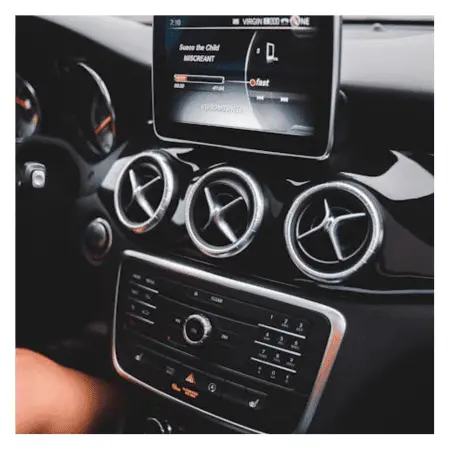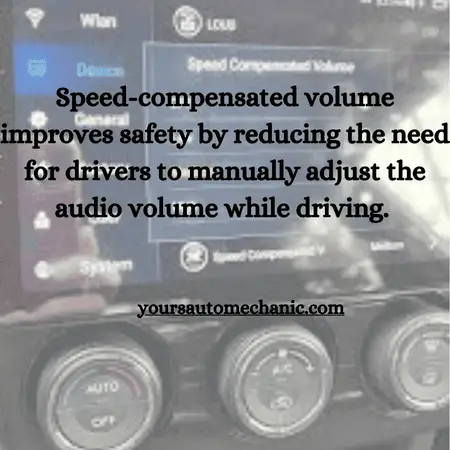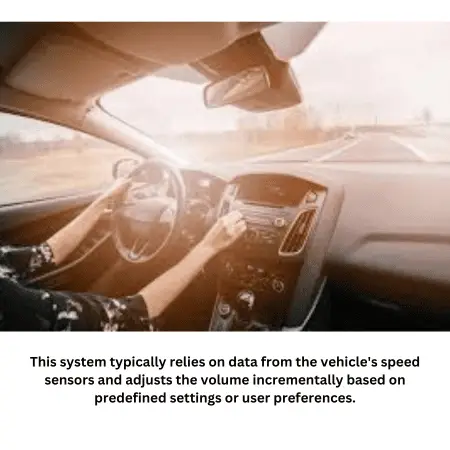Have you ever been driving on the road, and suddenly you can’t hear your favorite song because of the noise?
That’s where speed compensated volume comes in. It’s an ingenious feature in modern vehicles designed to adjust your audio system’s volume based on your driving speed.
This nifty technology ensures that your music or podcast maintains consistent audibility, enhancing your driving experience. In this article we will explore speed compensated volume and its different aspects. So keep on reading…
The Basics of Speed Compensated Volume
So, how does speed compensated volume work?
It’s a system that automatically adjusts your car’s audio volume in response to the vehicle’s speed. When you speed up, the volume increases; when you slow down, it decreases. This adjustment is seamless and designed to compensate for the varying levels of ambient noise you encounter as you drive.
The journey to speed compensated volume began with the early days of car audio systems. Initially, drivers had to manually adjust their volume to cope with road and wind noise.
Over time, as car audio systems became more sophisticated, the need for a more dynamic solution became apparent.
Enter speed-compensated volume, a feature that has revolutionized in-car audio by offering automatic volume control based on driving conditions.

Must Read
Technical Aspects of Speed Compensated Volume
Let’s dive into how your car’s Speed Compensated Volume (SCV) works.
1- Speed Detection and Signal Transmission
When you’re driving, the music’s volume adjusts itself based on how fast you’re going. This magic happens thanks to some clever technology.
First off, your car has speed sensors that keep an eye on how fast you’re moving. These sensors constantly measure your speed and send electrical signals to the car’s onboard computer, also known as the ECU. This real-time data gives the car’s systems a precise idea of your current speed.
2- Integration with the Audio System
The onboard computer processes these speed signals and passes the information to the audio system’s processor. This processor is like the brain of your car’s sound system. It uses the speed data to decide whether to increase or decrease the volume.
3- Automatic Volume Adjustment
As your speed increases, the audio processor bumps the volume to counteract the growing noise from the road and wind. This way, your music stays clear and loud enough to enjoy without you needing to fiddle with the volume knob. When you slow down, say when you’re cruising through a quiet neighborhood, the processor lowers the volume since there’s less background noise to contend with.
4- Customizable User Settings
You also have some control over this process. The car’s sound system usually has a user interface, often on the dashboard or the infotainment screen, where you can set your preferences for the SCV feature. You might adjust how sensitive the volume changes are or even turn the feature on and off based on your liking.

Benefits of Speed Compensated Volume
Consistent Audio Quality
One of the main benefits of Speed Compensated Volume (SCV) is the consistent audio quality it provides. As you drive, the volume adjusts automatically based on your speed, ensuring that your music or other audio content remains at an optimal level. This means you don’t have to keep adjusting the volume manually as you accelerate or decelerate, making your driving experience more enjoyable and less distracting.
Improved Safety
SCV enhances safety by reducing the need for you to interact with the car’s audio controls while driving. By automatically adjusting the volume, SCV allows you to keep your hands on the wheel and your eyes on the road, minimizing distractions and helping you focus better on driving.
Enhanced Listening Experience
As road and wind noise increase with speed, SCV compensates by increasing the volume, ensuring that you can still hear your audio clearly. When you slow down and the noise level decreases, the system lowers the volume, so it’s not too loud. This dynamic adjustment provides a more pleasant and comfortable listening experience throughout your journey.
Customizable to Your Preferences
Most SCV systems offer customizable settings, allowing you to tailor the volume adjustments to your liking. You can usually adjust the sensitivity of the SCV or choose different levels of compensation, giving you control over how the system responds to changes in speed. This personalization ensures that the audio system meets your specific preferences and needs.
Less Manual Adjustments
With SCV, you spend less time manually adjusting the volume, which can be especially beneficial on long drives or in fluctuating traffic conditions. The system takes care of the volume changes for you, providing a seamless and hassle-free audio experience.
Better Focus on Driving
By eliminating the need to frequently adjust the audio volume, SCV helps you maintain better concentration on the road. This is particularly useful in busy traffic or on highways, where keeping your attention on driving is crucial for safety.

limitations of speed compensated volume
Speed-compensated volume (SCV) systems, while useful, have several limitations:
Accuracy of Adjustment:
SCV systems rely on vehicle speed sensors, which might not always perfectly correlate with the actual noise levels inside the car. Factors like wind direction, road surface, and traffic conditions can vary the noise level independently of speed.
User Preferences:
The automatic adjustments might not align with individual preferences. Some users may find the changes in volume too drastic or insufficient, requiring manual adjustments.
System Complexity:
The sophistication of the SCV system can vary. Basic systems might only have a few levels of adjustment, whereas more advanced systems might be more precise. However, advanced systems can be more expensive and complex to maintain.
Environmental Noise Variability:
Noise levels inside the vehicle can be affected by factors other than speed, such as open windows, rain, or other external noises. SCV systems typically do not account for these variables, which can lead to suboptimal volume adjustments.
Delay in Adjustment: Some SCV systems may have a noticeable delay between changes in speed and volume adjustment, which can be distracting or annoying to the driver and passengers.
Compatibility with Audio Content: Different types of audio content (e.g., music, podcasts, phone calls) may require different volume levels. SCV systems may not distinguish between these content types, leading to inconsistent audio experiences.
Interference with Manual Controls: Frequent automatic adjustments can interfere with a user’s manual volume settings, leading to frustration if the user prefers to set the volume themselves.
Implementation of Speed Compensated Volume in Different Vehicles
Luxury vs. Standard Models
In luxury vehicles, Speed Compensated Volume (SCV) often comes as a standard feature. High-end car manufacturers like Mercedes-Benz, BMW, and Audi integrate SCV into their sophisticated infotainment systems. These systems not only adjust the volume based on speed but also offer a range of advanced features, such as:
In contrast, standard vehicle models might offer SCV as part of an optional package or in higher trim levels rather than a standard feature. The implementation, while functional, may be less customizable and integrated than in luxury vehicles:
Aftermarket Options
For vehicles that do not come with SCV from the factory, there are aftermarket options available. These solutions allow you to add SCV functionality to your existing car audio system:
- Standalone SCV Modules: These devices can be installed in your car to provide speed-based volume adjustments. They typically connect to the vehicle’s speed sensor and audio system, enabling volume changes based on speed.
- Aftermarket Head Units: Many aftermarket car stereos come with built-in SCV features. Brands like Pioneer, Kenwood, and Alpine offer head units that can replace your car’s existing stereo, providing not only SCV but also a range of modern features like Bluetooth connectivity, navigation, and enhanced sound quality.
You May Find Helpful
- Can You Drive Without a Muffler? Pros & Cons Of Removing Mufflers
- Is It Safe To Drive Without Power Steering?
- Is It Safe To Drive With ABS Light On? ( Detailed Answer )
Conclusion
Speed-compensated volume is a remarkable feature that enhances the driving experience by automatically adjusting the audio volume based on the vehicle’s speed. It offers numerous benefits, including improved safety, enhanced comfort, and customization options tailored to individual preferences. As automotive technology continues to evolve, SCV systems will become even more sophisticated, providing a seamless and enjoyable audio experience for all drivers.
